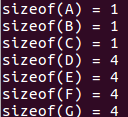例一:

#include <iostream> using namespace std; class A { public: char c; }; class B { public: int a; short b; }; class C { public: int a; short b; char c; }; class D { public: int a; short b; char c; char d; }; class E { public: int a; short b; char c; char d; char e; }; int main() { cout<< "sizeof(A) = " <<sizeof(A) << endl; cout<< "sizeof(B) = " <<sizeof(B) << endl; cout<< "sizeof(C) = " <<sizeof(C) << endl; cout<< "sizeof(D) = " <<sizeof(D) << endl; cout<< "sizeof(E) = " <<sizeof(E) << endl; return 0; }
输出:

这里是32位机器,sizeof(B)=8,sizeof(C)=8,sizeof(E)=12的原因是字节对齐,编译器会在最末一个成员之后填充字节。
例二:

#include <iostream> using namespace std; class Base { public: Base(int x) : a(x) {} void print() { cout << "Base" << endl; } private: int a; }; class Derived : public Base { public: Derived(int x) : Base(x - 1), b(x) {} void print() { cout << "Derived" << endl; } private: int b; }; class A { public: A(int x) : a(x) {} virtual void print() { cout << "A" << endl; } private: int a; }; class B : public A { public: B(int x) : A(x - 1), b(x) {} virtual void print() { cout << "B" << endl; } private: int b; }; int main() { cout<< "sizeof(Base) = " <<sizeof(Base) << endl; cout<< "sizeof(Derived) = " <<sizeof(Derived) << endl; cout<< "sizeof(A) = " <<sizeof(A) << endl; cout<< "sizeof(B) = " <<sizeof(B) << endl; return 0; }
输出:

sizeof(Base)=4,int占4字节,print()函数不占内存;
sizeof(Derived)=8,比Base多一个int成员;
sizeof(A)=8,int占4字节,但是含有虚函数,包含了一个隐含的虚表指针成员,占4字节,共计8字节;
sizeof(B)=12,比A多一个int成员,共计12字节;
这里可能会存在一个疑问:B中也存在一个指向虚函数表的指针,所以应该是16字节。
解释:虚表指针(vptr)是作为对象的一部分存在于对象的空间中,一个类只有一个虚表指针,所以A中的虚表指针和B中的虚表指针是同一个,所以是12字节。
例三:

#include <iostream> using namespace std; class A { }; class B { }; class C : public A, public B { }; class D : virtual public A { }; class E : virtual public A, virtual public B { }; class F : public D { }; class G { public: int a; static int b; }; int main() { cout<< "sizeof(A) = " <<sizeof(A) << endl; cout<< "sizeof(B) = " <<sizeof(B) << endl; cout<< "sizeof(C) = " <<sizeof(C) << endl; cout<< "sizeof(D) = " <<sizeof(D) << endl; cout<< "sizeof(E) = " <<sizeof(E) << endl; cout<< "sizeof(F) = " <<sizeof(F) << endl; cout<< "sizeof(G) = " <<sizeof(G) << endl; return 0; }
输出:

sizeof(A) = 1,类A是空类,编译器会安插一个char空类,标记它的每一个对象,因此为1字节;
sizeof(B) = 1,同上;
sizeof(C) = 1,类C多重继承类A和类B,大小仍然为1字节;
sizeof(D) = 4,类D虚继承自A,编译器安插了一个指向父类的指针,大小为4字节;
sizeof(E) = 4,类E虚继承自A和B,因此它有指向父类A和父类B的指针,加起来为8字节。注意:在GNU编译器下编译字节是4字节;
sizeof(F) = 4,类F继承D,大小为4字节;
sizeof(G) = 4,类G有一个static成员,这个静态成员不在类的实例中,而是像全局变量一样在静态存储区中,被类G共享,所以只计算一个int成员,为4字节;
PS:如果在A中加入char a;
输出:sizeof(D) = 8 sizeof(E) = 8 sizeof(F) = 8 ,理由是字节对齐。
例四:

#include <iostream> using namespace std; union u1 { double a; int b; }; union u2 { char a[13]; int b; }; union u3 { char a[13]; char b; }; int main() { cout<< "sizeof(u1) = " <<sizeof(u1) << endl; cout<< "sizeof(u2) = " <<sizeof(u2) << endl; cout<< "sizeof(u3) = " <<sizeof(u3) << endl; return 0; }
输出:

这里定义了三个联合体。联合体的大小取决于它所有成员中占用空间最大的一个成员的大小。对于符合数据类型,例如union,struct,class,对齐方式为成员中最大成员的对齐方式。
sizeof(u1) = 8,最大成员为double a,为8;
sizeof(u2) = 16,最大成员是char[13]的数组,但由于另一个成员int b,使u2的对齐方式变成4,所以u2的大小为4的倍数,所以占用的空间由13对齐成16;
sizeof(u3) = 13,最大成员是char[13]的数组,另一个成员char b,所以大小为13;
例五:(查看32位和64位机器字节大小)
#include <iostream> using namespace std; int main() { cout<< "sizeof(char) = " <<sizeof(char) << endl; cout<< "sizeof(short) = " <<sizeof(short) << endl; cout<< "sizeof(int) = " << sizeof(int) <<endl; cout<< "sizeof(double) = " <<sizeof(double) << endl; cout<< "sizeof(long) = " <<sizeof(long) << endl; cout<< "sizeof(longlong) = " <<sizeof(long long) << endl; cout<< "sizeof(void*) = " << sizeof(void*) <<endl; cout<< "sizeof(char*) = " << sizeof(char*) <<endl; cout<< "当前系统是sizeof(void*) * 8 = " << sizeof(void*)*8<<"位"<<endl; return 0; }
32位输出:

64位输出:
sizeof(char) = 1
sizeof(short) = 2
sizeof(int) = 4
sizeof(double) = 8
sizeof(long) = 8
sizeof(longlong) = 8
sizeof(void*) = 8
sizeof(char*) = 8
当前系统是sizeof(void*) * 8 = 64位
说明:
1.long型变量在32位是4字节,64位是8字节
2.指针变量在32位是4字节,64位是8字节
